Surface State across Scales; Temporal and Spatial Patterns in Land Surface Freeze/Thaw Dynamics †
Abstract
1. Introduction
2. Materials and Methods
3. Results
4. Discussion
4.1. Spatial Patterns
4.2. Temporal Patterns
4.3. Importance of Landscape Types on the Issue of Scale
4.4. Influence of Data Quality
5. Conclusions
Acknowledgments
Author Contributions
Conflicts of Interest
References
- Kimball, J.; McDonald, K.; Frolking, S.; Running, S. Radar remote sensing of the spring thaw transition across a boreal landscape. Remote Sens. Environ. 2004, 89, 163–175. [Google Scholar] [CrossRef]
- Yi, Y.; Kimball, J.S.; Jones, L.A.; Reichle, R.H.; Nemani, R.; Margolis, H.A. Recent climate and fire disturbance impacts on boreal and arctic ecosystem productivity estimated using a satellite-based terrestrial carbon flux model. J. Geophys. Res. Biogeosci. 2013, 118, 606–622. [Google Scholar] [CrossRef]
- Wang, G.; Hu, H.; Li, T. The influence of freeze-thaw cycles of active soil layer on surface runoff in a permafrost watershed. J. Hydrol. 2009, 375, 438–449. [Google Scholar] [CrossRef]
- Qi, J.; Vermeer, P.A.; Cheng, G. A review of the influence of freeze-thaw cycles on soil geotechnical properties. Permafr. Periglac. Process. 2006, 17, 245–252. [Google Scholar] [CrossRef]
- Manasypov, R.M.; Vorobyev, S.N.; Loiko, S.V.; Kritzkov, I.V.; Shirokova, L.S.; Shevchenko, V.P.; Kirpotin, S.N.; Kulizhsky, S.P.; Kolesnichenko, L.G.; Zemtzov, V.A.; et al. Seasonal dynamics of organic carbon and metals in thermokarst lakes from the discontinuous permafrost zone of western Siberia. Biogeosciences 2015, 12, 3009–3028. [Google Scholar] [CrossRef]
- Gruber, S.; Hoelzle, M.; Haeberli, W. Permafrost thaw and destabilization of Alpine rock walls in the hot summer of 2003. Geophys. Res. Lett. 2004, 31, L13504. [Google Scholar] [CrossRef]
- Mastepanov, M.; Sigsgaard, C.; Dlugokencky, E. Large tundra methane burst during onset of freezing. Nature 2008, 456, 628–630. [Google Scholar] [CrossRef] [PubMed]
- Zhang, T.; Barry, R.G.; Armstrong, R.L. Application of Satellite Remote Sensing Techniques to Frozen Ground Studies. Polar Geogr. 2004, 28, 163–196. [Google Scholar] [CrossRef]
- Raynolds, M.K.; Walker, D.A.; Ambrosius, K.J.; Brown, J.; Everett, K.R.; Kanevskiy, M.; Kofinas, G.P.; Romanovsky, V.E.; Shur, Y.; Webber, P.J. Cumulative geoecological effects of 62 years of infrastructure and climate change in ice-rich permafrost landscapes, Prudhoe Bay Oilfield, Alaska. Glob. Chang. Biol. 2014, 20, 1211–1224. [Google Scholar] [CrossRef] [PubMed]
- Schaefer, K.; Zhang, T.; Bruhwiler, L.; Barrett, A.P. Amount and timing of permafrost carbon release in response to climate warming. Tellus Ser. B 2011, 63, 165–180. [Google Scholar] [CrossRef]
- Spencer, R.G.M.; Mann, P.J.; Dittmar, T.; Eglinton, T.I.; McIntyre, C.; Holmes, R.M.; Zimov, N.; Stubbins, A. Detecting the signature of permafrost thaw in Arctic rivers. Geophys. Res. Lett. 2015, 42, 2830–2835. [Google Scholar] [CrossRef]
- Grosse, G.; Goetz, S.; McGuire, A.D.; Romanovsky, V.E.; Schuur, E.A.G. Changing permafrost in a warming world and feedbacks to the Earth system. Environ. Res. Lett. 2016, 11, 040201. [Google Scholar] [CrossRef]
- Vincent, W.F.; Lemay, M.; Allard, M. Arctic permafrost landscapes in transition: Towards an integrated Earth system approach. Arct. Sci. 2017, 3, 39–64. [Google Scholar] [CrossRef]
- Podest, E.; McDonald, K.C.; Kimball, J.S. Multisensor Microwave Sensitivity to Freeze/Thaw Dynamics Across a Complex Boreal Landscape. IEEE Trans. Geosci. Remote Sens. 2014, 52, 6818–6828. [Google Scholar] [CrossRef]
- Wegmüller, U. The effect of freezing and thawing on the microwave signatures of bare soil. Remote Sens. Environ. 1990, 33, 123–135. [Google Scholar] [CrossRef]
- Kimball, J.; McDonald, K.; Keyser, A.; Frolking, S.; Running, S. Application of the NASA Scatterometer (NSCAT) for Determining the Daily Frozen and Nonfrozen Landscape of Alaska. Remote Sens. Environ. 2001, 75, 113–126. [Google Scholar] [CrossRef]
- Rautiainen, K.; Parkkinen, T.; Lemmetyinen, J.; Schwank, M.; Wiesmann, A.; Ikonen, J.; Derksen, C.; Davydov, S.; Davydova, A.; Boike, J.; et al. SMOS prototype algorithm for detecting autumn soil freezing. Remote Sens. Environ. 2016, 180, 346–360. [Google Scholar] [CrossRef]
- Xu, X.; Derksen, C.; Yueh, S.H.; Dunbar, R.S.; Colliander, A. Freeze/Thaw Detection and Validation Using Aquarius’ L-Band Backscattering Data. IEEE J. Sel. Top. Appl. Earth Obs. Remote Sens. 2016, 9, 1370–1381. [Google Scholar] [CrossRef]
- Zwieback, S.; Paulik, C.; Wagner, W. Frozen Soil Detection Based on Advanced Scatterometer Observ. and Air Temperature Data as Part of Soil Moisture Retrieval. Remote Sens. 2015, 7, 3206–3231. [Google Scholar] [CrossRef]
- Naeimi, V.; Paulik, C.; Bartsch, A.; Wagner, W.; Kidd, R.; Park, S.E.; Elger, K.; Bioke, J. ASCAT Surface State Flag (SSF): Extracting Information on Surface Freeze/Thaw Conditions From Backscatter Data Using an Empirical Threshold-Analysis Algorithm. IEEE Trans. Geosci. Remote Sens. 2012, 50, 2566–2582. [Google Scholar] [CrossRef]
- Högström, E.; Trofaier, A.M.; Gouttevin, I.; Bartsch, A. Assessing Seasonal Backscatter Variations with Respect to Uncertainties in Soil Moisture Retrieval in Siberian Tundra Regions. Remote Sens. 2014, 6, 8718–8738. [Google Scholar] [CrossRef]
- Boehnke, K.; Wismann, V.R. Thawing of soils in Siberia observed by the ERS-1 scatterometer between 1992 and 1995. In Proceedings of the International Geoscience and Remote Sensing Symposium, IGARSS ’96—Remote Sensing for a Sustainable Future, Lincoln, NE, USA, 31 May 1996; Volume 4, pp. 2264–2266. [Google Scholar]
- Bartsch, A.; Kidd, R.A.; Wagner, W.; Bartalis, Z. Temporal and spatial variability of the beginning and end of daily spring freeze/thaw cycles derived from scatterometer data. Remote Sens. Environ. 2007, 106, 360–374. [Google Scholar] [CrossRef]
- Bartsch, A.; Kumpula, T.; Forbes, B.C.; Stammler, F. Detection of snow surface thawing and refreezing in the Eurasian Arctic with QuikSCAT: Implications for reindeer herding. Ecol. Appl. 2010, 20, 2346–2358. [Google Scholar] [CrossRef] [PubMed]
- Foster, J.L.; Hall, D.K.; Eylander, J.B.; Riggs, G.A.; Nghiem, S.V.; Tedesco, M.; Kim, E.; Montesano, P.M.; Kelly, R.E.J.; Casey, K.A.; et al. A blended global snow product using visible, passive microwave and scatterometer satellite data. Int. J. Remote Sens. 2011, 32, 1371–1395. [Google Scholar] [CrossRef]
- Wang, L.; Derksen, C.; Brown, R. Detection of pan-Arctic terrestrial snowmelt from QuikSCAT, 2000–2005. Remote Sens. Environ. 2008, 112, 3794–3805. [Google Scholar] [CrossRef]
- Widhalm, B.; Bartsch, A.; Heim, B. A Novel Approach for the Characterization of Tundra Wetland Regions with C-band SAR Satellite Data. Int. J. Remote Sens. 2015, 36, 5537–5556. [Google Scholar] [CrossRef] [PubMed]
- Brown, R.; Derksen, C.; Wang, L. Assessment of spring snow cover duration variability over northern Canada from satellite datasets. Remote Sens. Environ. 2007, 111, 367–381. [Google Scholar] [CrossRef]
- Zwieback, S.; Bartsch, A.; Melzer, T.; Wagner, W. Probabilistic Fusion of Ku—And C-band Scatterometer Data for Determining the Freeze/Thaw State. IEEE Trans. Geosci. Remote Sens. 2012, 50, 2583–2594. [Google Scholar] [CrossRef]
- Drobot, S.D.; Anderson, M.R. An improved method for determining snowmelt onset dates over Arctic sea ice using scanning multichannel microwave radiometer and Special Sensor Microwave/Imager data. J. Geophys. Res. Atmos. 2001, 106, 24033–24049. [Google Scholar] [CrossRef]
- Winebrenner, D.P.; Nelson, E.D.; Colony, R.; West, R.D. Observation of melt onset on multiyear Arctic sea ice using the ERS 1 synthetic aperture radar. J. Geophys. Res. Oceans 1994, 99, 22425–22441. [Google Scholar] [CrossRef]
- Mortin, J.; Howell, S.E.; Wang, L.; Derksen, C.; Svensson, G.; Graversen, R.G.; Schrøder, T.M. Extending the QuikSCAT record of seasonal melt–freeze transitions over Arctic sea ice using ASCAT. Remote Sens. Environ. 2014, 141, 214–230. [Google Scholar] [CrossRef]
- Howell, S.E.; Derksen, C.; Tivy, A. Development of a water clear of sea ice detection algorithm from enhanced SeaWinds/QuikSCAT and AMSR-E measurements. Remote Sens. Environ. 2010, 114, 2594–2609. [Google Scholar] [CrossRef]
- Derksen, C.; Xu, X.; Dunbar, R.S.; Colliander, A.; Kim, Y.; Kimball, J.S.; Black, T.A.; Euskirchen, E.; Langlois, A.; Loranty, M.M.; et al. Retrieving landscape freeze/thaw state from Soil Moisture Active Passive (SMAP) radar and radiometer measurements. Remote Sens. Environ. 2017, 194, 48–62. [Google Scholar] [CrossRef]
- Park, S.E.; Bartsch, A.; Sabel, D.; Wagner, W.; Naeimi, V.; Yamaguchi, Y. Monitoring freeze/thaw cycles using ENVISAT ASAR Global Mode. Remote Sens. Environ. 2011, 115, 3457–3467. [Google Scholar] [CrossRef]
- Park, H.; Kim, Y.; Kimball, J.S. Widespread permafrost vulnerability and soil active layer increases over the high northern latitudes inferred from satellite remote sensing and process model assessments. Remote Sens. Environ. 2016, 175, 349–358. [Google Scholar] [CrossRef]
- Roy, A.; Toose, P.; Williamson, M.; Rowlandson, T.; Derksen, C.; Royer, A.; Berg, A.A.; Lemmetyinen, J.; Arnold, L. Response of L-Band brightness temperatures to freeze/thaw and snow dynamics in a prairie environment from ground-based radiometer measurements. Remote Sens. Environ. 2017, 191, 67–80. [Google Scholar] [CrossRef]
- Rautiainen, K.; Lemmetyinen, J.; Schwank, M.; Kontu, A.; Ménard, C.B.; Mätzler, C.; Drusch, M.; Wiesmann, A.; Ikonen, J.; Pulliainen, J. Detection of soil freezing from L-band passive microwave observations. Remote Sens. Environ. 2014, 147, 206–218. [Google Scholar] [CrossRef]
- Rignot, E.; Way, J.B. Monitoring Freeze-Thaw Cycles along North-South Alaskan Transects Using ERS-1 SAR. Remote Sens. Environ. 1994, 49, 131–137. [Google Scholar] [CrossRef]
- Way, J.B.; Zimmermann, R.; Rignot, E.; McDonald, K.; Oren, R. Winter and spring thaw as observed with imaging radar at BOREAS. J. Geophys. Res. Atmos. 1997, 102, 29673–29684. [Google Scholar] [CrossRef]
- Sabel, D.; Park, S.E.; Bartsch, A.; Schlaffer, S.; Klein, J.P.; Wagner, W. Regional Surface Soil Moisture and Freeze/Thaw Timing Remote Sensing Products with Links to Geotiff Images. 2012. Available online: https://doi.pangaea.de/10.1594/PANGAEA.779658 (accessed on 20 November 2015).
- Paulik, C.; Melzer, T.; Hahn, S.; Bartsch, A.; Heim, B.; Elger, K.; Wagner, W. Circumpolar Surface Soil Moisture and Freeze/Thaw Surface Status Remote Sensing Products (Version 4) with Links to Geotiff Images and NetCDF Files (2007-01 to 2013-12). 2014. Available online: https://doi.pangaea.de/10.1594/PANGAEA.832153 (accessed on 20 November 2015).
- Roy, A.; Royer, A.; Derksen, C.; Brucker, L.; Langlois, A.; Mialon, A.; Kerr, Y.H. Evaluation of Spaceborne L-Band Radiometer Measurements for Terrestrial Freeze/Thaw Retrievals in Canada. IEEE J. Sel. Top. Appl. Earth Obs. Remote Sens. 2015, 8, 4442–4459. [Google Scholar] [CrossRef]
- Entekhabi, D.; Njoku, E.G.; O’Neill, P.E.; Kellogg, K.H.; Crow, W.T.; Edelstein, W.N.; Entin, J.K.; Goodman, S.D.; Jackson, T.J.; Johnson, J.; et al. The Soil Moisture Active Passive (SMAP) Mission. Proc. IEEE 2010, 98, 704–716. [Google Scholar] [CrossRef]
- Lindsley, R.D.; Long, D.G. Enhanced-Resolution Reconstruction of ASCAT Backscatter Measurements. IEEE Trans. Geosci. Remote Sens. 2016, 54, 2589–2601. [Google Scholar] [CrossRef]
- Bartsch, A.; Seifert, F.M. The ESA DUE Permafrost project—A service for high latitude research. In Proceedings of the 2012 IEEE International Geoscience and Remote Sensing Symposium (IGARSS), Munich, Germany, 22–27 July 2012; pp. 5222–5225. [Google Scholar]
- Rodell, M.; Houser, P.R.; Jambor, U.E.A.; Gottschalck, J.; Mitchell, K.; Meng, C.J.; Arsenault, K.; Cosgrove, B.; Radakovich, J.; Bosilovich, M. The global land data assimilation system. Bull. Am. Meteorol. Soc. 2004, 85, 381–394. [Google Scholar] [CrossRef]
- Dee, D.P.; Uppala, S.M.; Simmons, A.J.; Berrisford, P.; Poli, P.; Kobayashi, S.; Andrae, U.; Balmaseda, M.A.; Balsamo, G.; Bauer, P.; et al. The ERA-Interim reanalysis: Configuration and performance of the data assimilation system. Q. J. R. Meteorol. Soc. 2011, 137, 553–597. [Google Scholar] [CrossRef]
- Bartsch, A.; Pointner, G.; Leibman, M.O.; Dvornikov, Y.A.; Khomutov, A.V.; Trofaier, A.M. Circumpolar Mapping of Ground-Fast Lake Ice. Front. Earth Sci. 2017, 5, 12. [Google Scholar] [CrossRef]
- Pathe, C.; Wagner, W.; Sabel, D.; Doubkova, M.; Basara, J.B. Using ENVISAT ASAR Global Mode Data for Surface Soil Moisture Retrieval Over Oklahoma, USA. IEEE Trans. Geosci. Remote Sens. 2009, 47, 468–480. [Google Scholar] [CrossRef]
- Latifovic, R.; Zhu, Z.; Cihlar, J.; Beaubien, J.; Fraser, R. The Land Cover Map for North America in the Year 2000, GLC2000 Database; European Commision Joint Research Centre: Brussels, Belgium, 2003; Available online: http://www-gem.jrc.it/glc2000 (accessed on 20 February 2017).
- Belward, A.S.; Erchov, D.V.; Isaev, A.S.; Bartholom, E.; Gond, V.; Vogt, P.; Achard, F.; Zubkov, A.M.; Mollicone, D.; Savin, I.; et al. The Land Cover Map for Northern Eurasia for the Year 2000, GLC2000 Database; European Commision Joint Research Centre: Brussels, Belgium, 2003; Available online: http://www-gem.jrc.it/glc2000 (accessed on 20 February 2017).
- Brown, O.; Heginbottom, J.; Melnikov, E. Circum-Arctic Map of Permafrost and Ground-Ice Conditions, 2nd ed.; National Snow and Ice Data Center: Boulder, CO, USA, 2002. [Google Scholar]
- Kane, D.; Hinzman, L. Climate Data from the North Slope Hydrology Research Project. University of Alaska Fairbanks, Water and Environmental Research Center, 2017. Available online: http://ine.uaf.edu/werc/projects/NorthSlope/ (accessed on 2 July 2017).
- GTN-P. Global Terrestrial Network for Permafrost Database: Permafrost Temperature Data (TSP—Thermal State of Permafrost); International Permafrost Association: Akureyri, Iceland, 2016. [Google Scholar]
- Santoro, M.; Strozzi, T. Circumpolar Digital Elevation Models > 55° N with Links to Geotiff Images. 2012. Available online: https://doi.pangaea.de/10.1594/PANGAEA.779748 (accessed on 20 April 2017).
- Reschke, J.; Bartsch, A.; Schlaffer, S.; Schepaschenko, D. Capability of C-Band SAR for Operational Wetland Monitoring at High Latitudes. Remote Sens. 2012, 4, 2923–2943. [Google Scholar] [CrossRef]
- Sturtevant, C.S.; Oechel, W.C. Spatial variation in landscape-level CO2 and CH4 fluxes from arctic coastal tundra: Influence from vegetation, wetness, and the thaw lake cycle. Glob. Chang. Biol. 2013, 19, 2853–2866. [Google Scholar] [CrossRef] [PubMed]
- Hinkel, K.; Paetzold, F.; Nelson, F.; Bockheim, J. Patterns of soil temperature and moisture in the active layer and upper permafrost at Barrow, Alaska: 1993–1999. Glob. Planet. Chang. 2001, 29, 293–309. [Google Scholar] [CrossRef]
- Han, L.; Tsunekawa, A.; Tsubo, M. Monitoring near-surface soil freeze–thaw cycles in northern China and Mongolia from 1998 to 2007. Int. J. Appl. Earth Obs. Geoinf. 2010, 12, 375–384. [Google Scholar] [CrossRef]
- Balsamo, G.; Albergel, C.; Beljaars, A.; Boussetta, S.; Brun, E.; Cloke, H.; Dee, D.; Dutra, E.; Muñoz Sabater, J.; Pappenberger, F.; et al. ERA-Interim/Land: A global land surface reanalysis dataset. Hydrol. Earth Syst. Sci. 2015, 19, 389–407. [Google Scholar] [CrossRef]
- Bartsch, A. Ten Years of SeaWinds on QuikSCAT for Snow Applications. Remote Sens. 2010, 2, 1142–1156. [Google Scholar] [CrossRef]
- Davis, R.E.; Hardy, J.P.; Ni, W.; Woodcock, C.; McKenzie, J.C.; Jordan, R.; Li, X. Variation of snow cover ablation in the boreal forest: A sensitivity study on the effects of conifer canopy. J. Geophys. Res. Atmos. 1997, 102, 29389–29395. [Google Scholar] [CrossRef]
- Du, J.; Kimball, J.S.; Duguay, C.; Kim, Y.; Watts, J.D. Satellite microwave assessment of Northern Hemisphere lake ice phenology from 2002 to 2015. Cryosphere 2017, 11, 47–63. [Google Scholar] [CrossRef]
- Bartsch, A.; Trofaier, A.M.; Hayman, G.; Sabel, D.; Schlaffer, S.; Clark, D.B.; Blyth, E. Detection of open water dynamics with ENVISAT ASAR in support of land surface modeling at high latitudes. Biogeosciences 2012, 9, 703–714. [Google Scholar] [CrossRef]
- Trofaier, A.M.; Bartsch, A.; Rees, W.G.; Leibman, M.O. Assessment of spring floods and surface water extent over the Yamalo-Nenets Autonomous District. Environ. Res. Lett. 2013, 8, 045026. [Google Scholar] [CrossRef]
- Muster, S.; Roth, K.; Langer, M.; Lange, S.; Cresto Aleina, F.; Bartsch, A.; Morgenstern, A.; Grosse, G.; Jones, B.; Sannel, A.B.K.; et al. PeRL: A Circum-Arctic Permafrost Region Pond and Lake Database. Earth Syst. Sci. Data 2016, 2016, 1–46. [Google Scholar] [CrossRef]
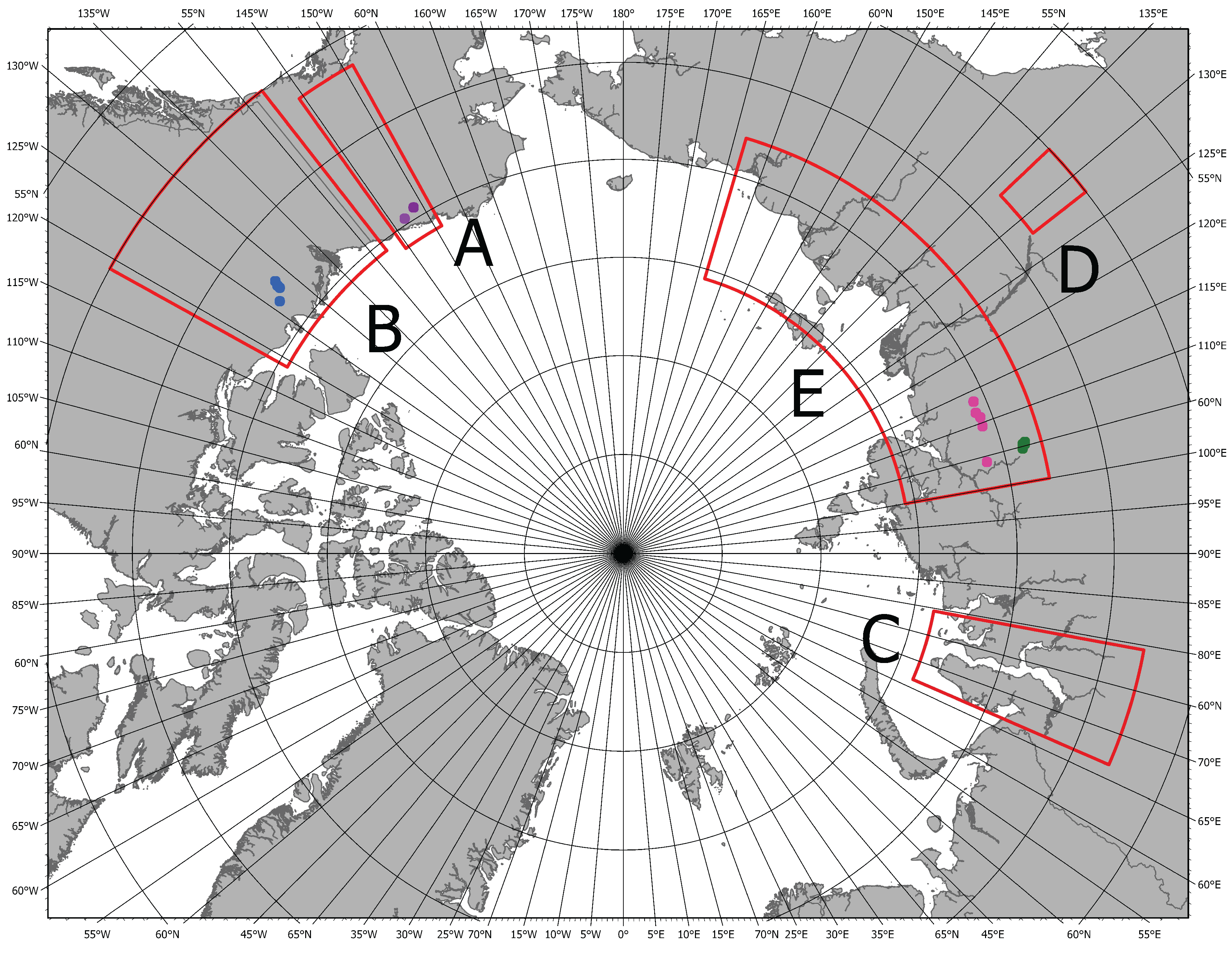
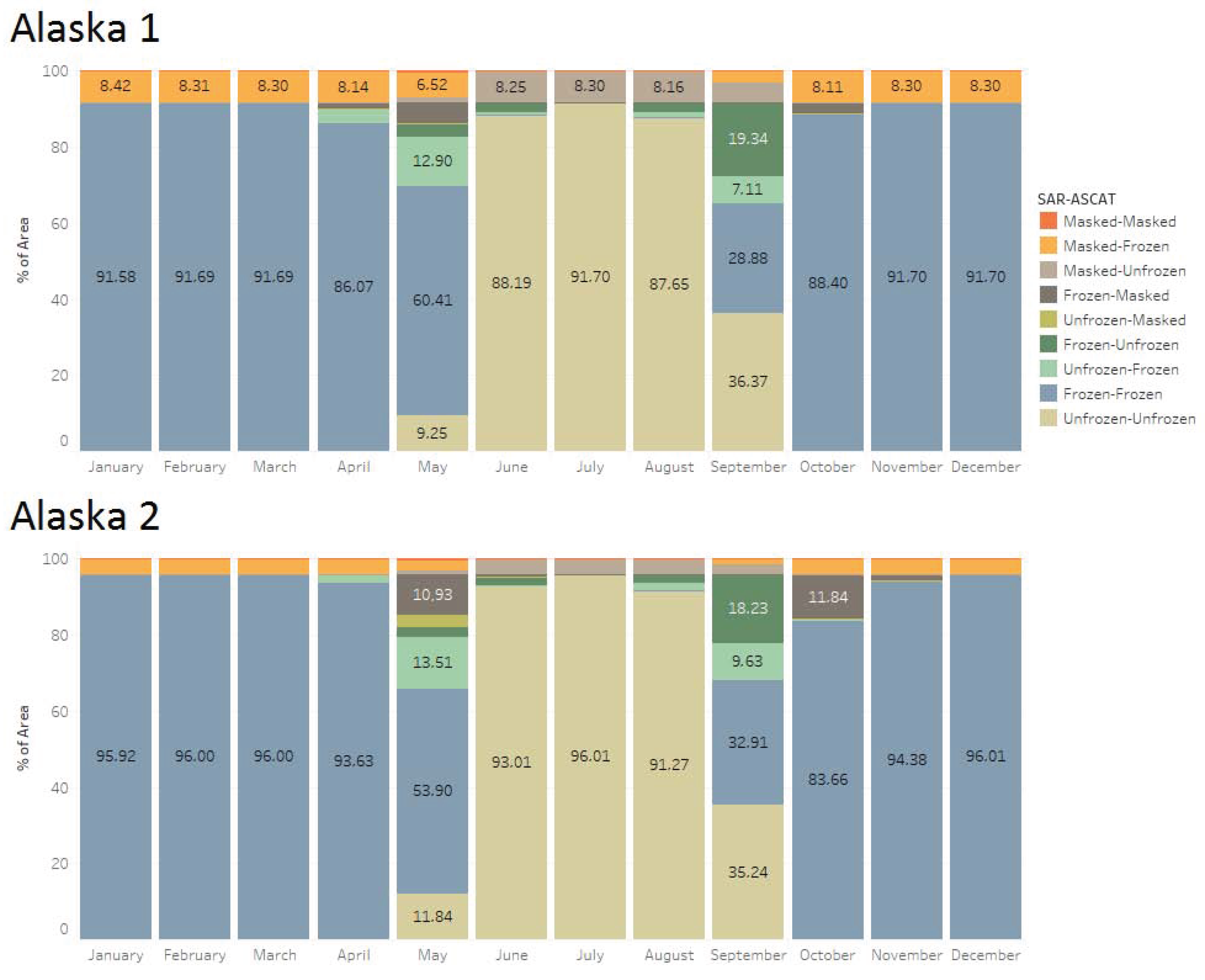
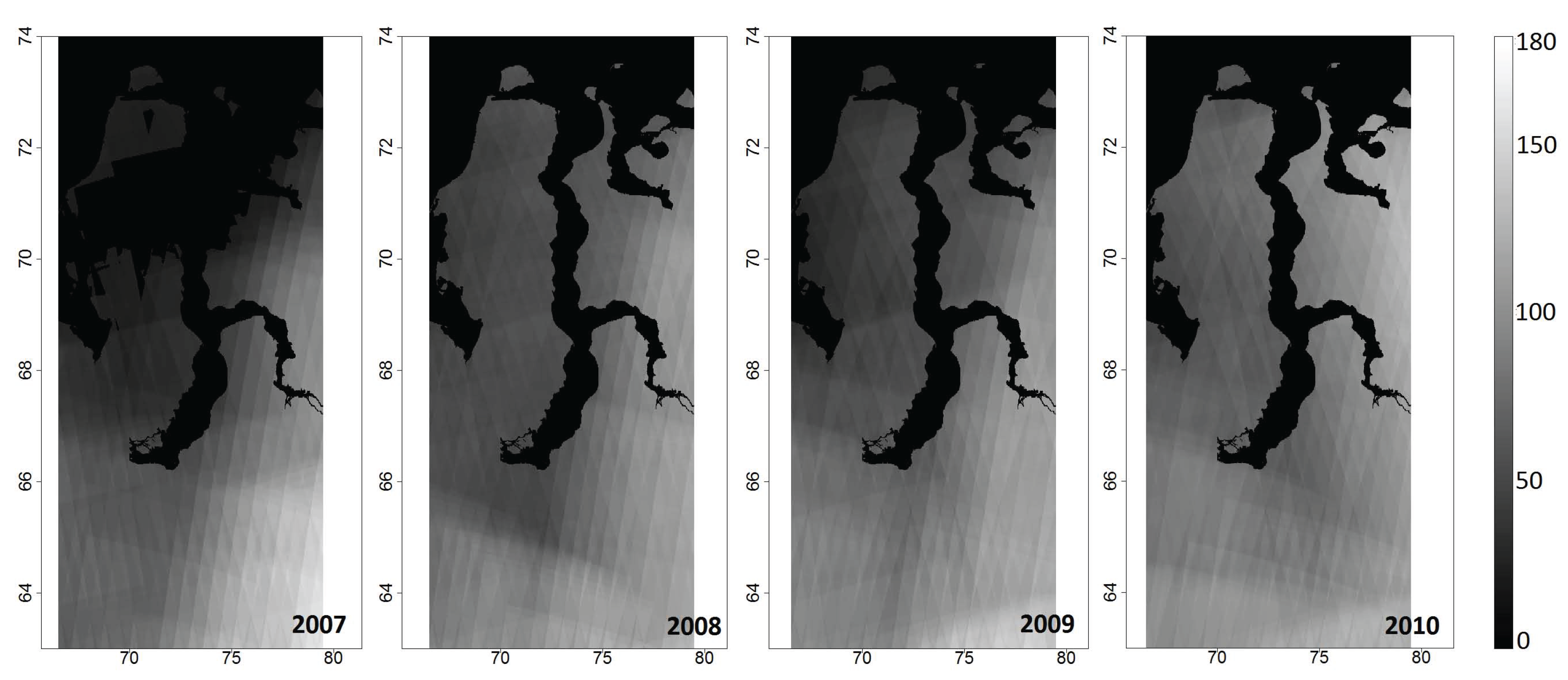
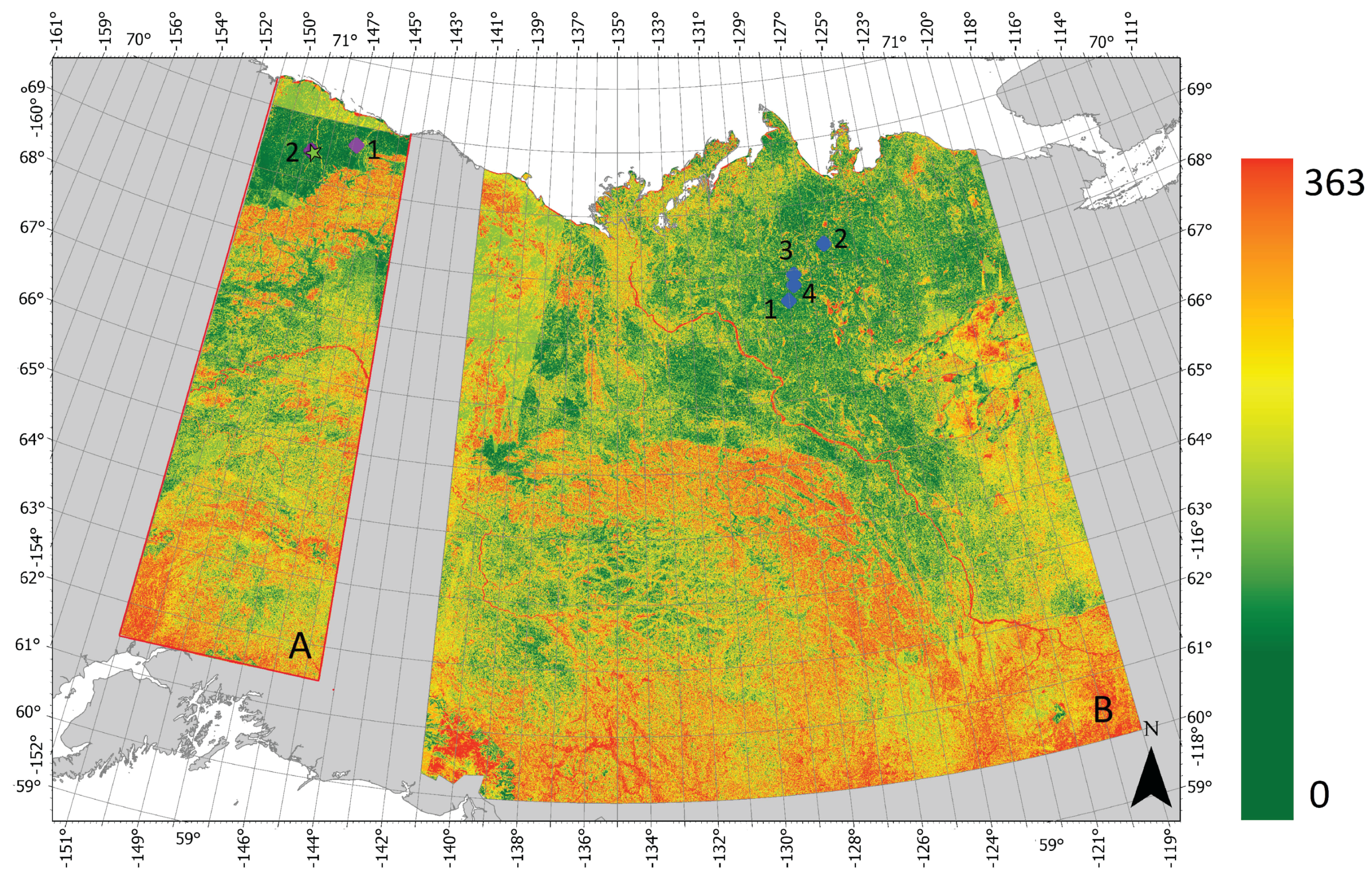
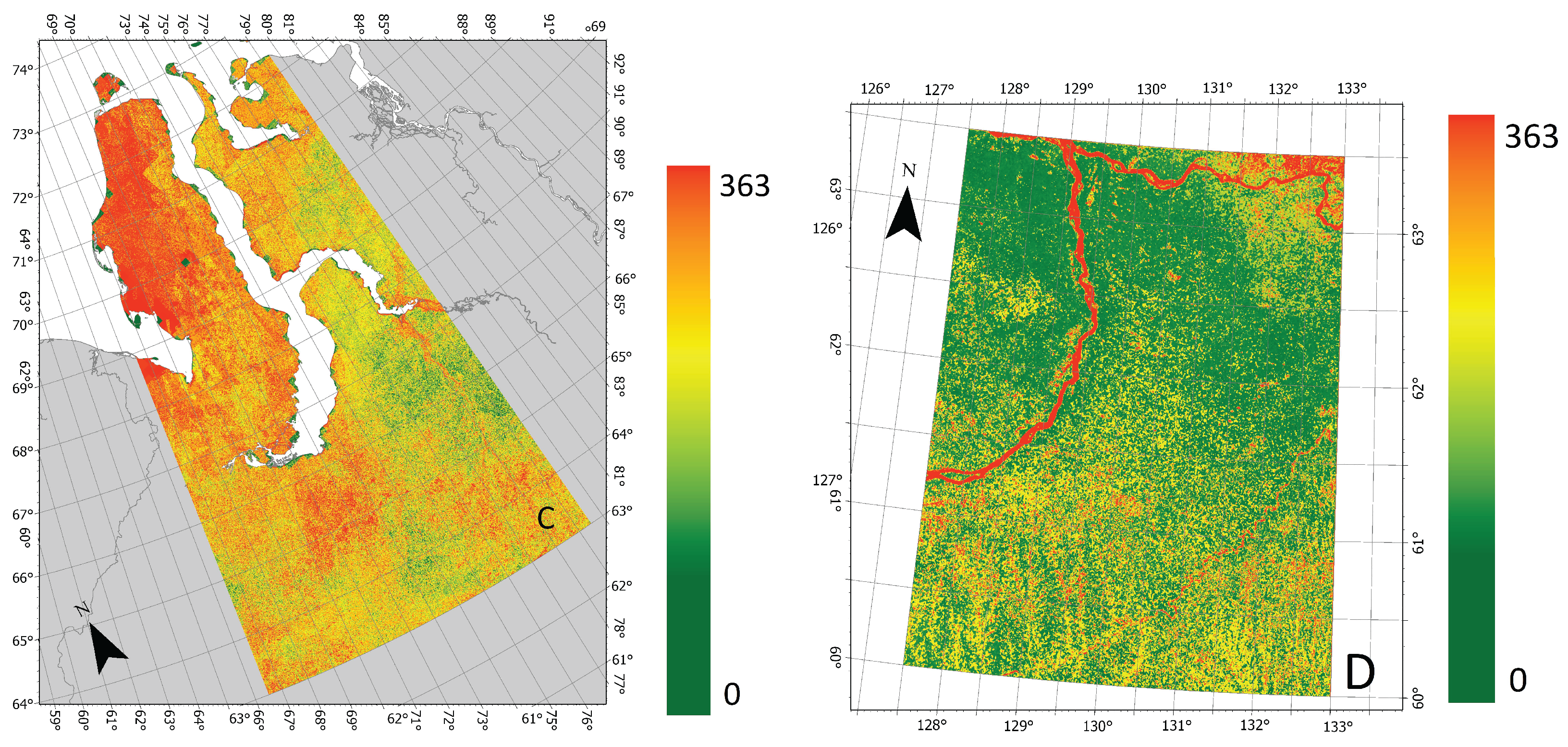
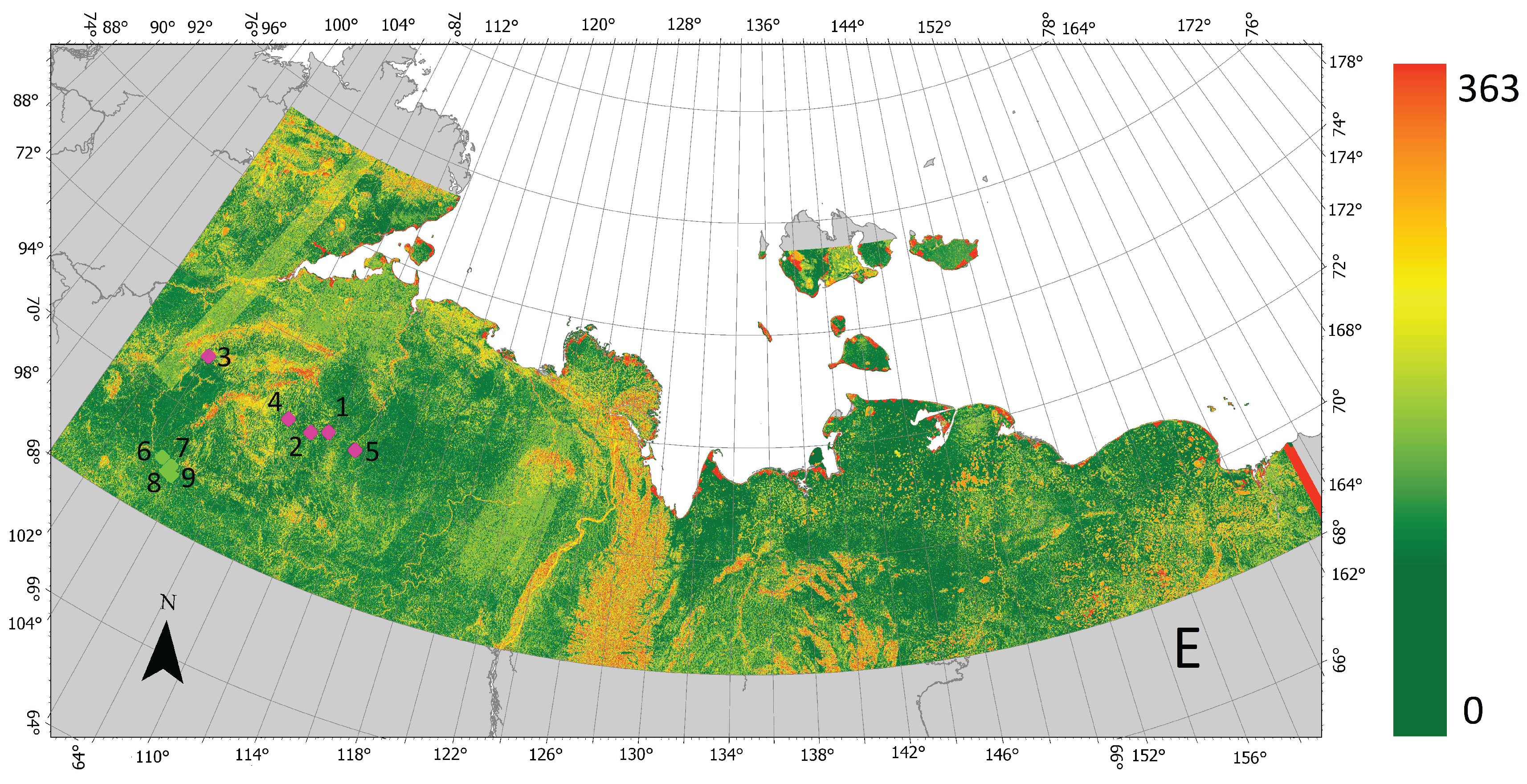
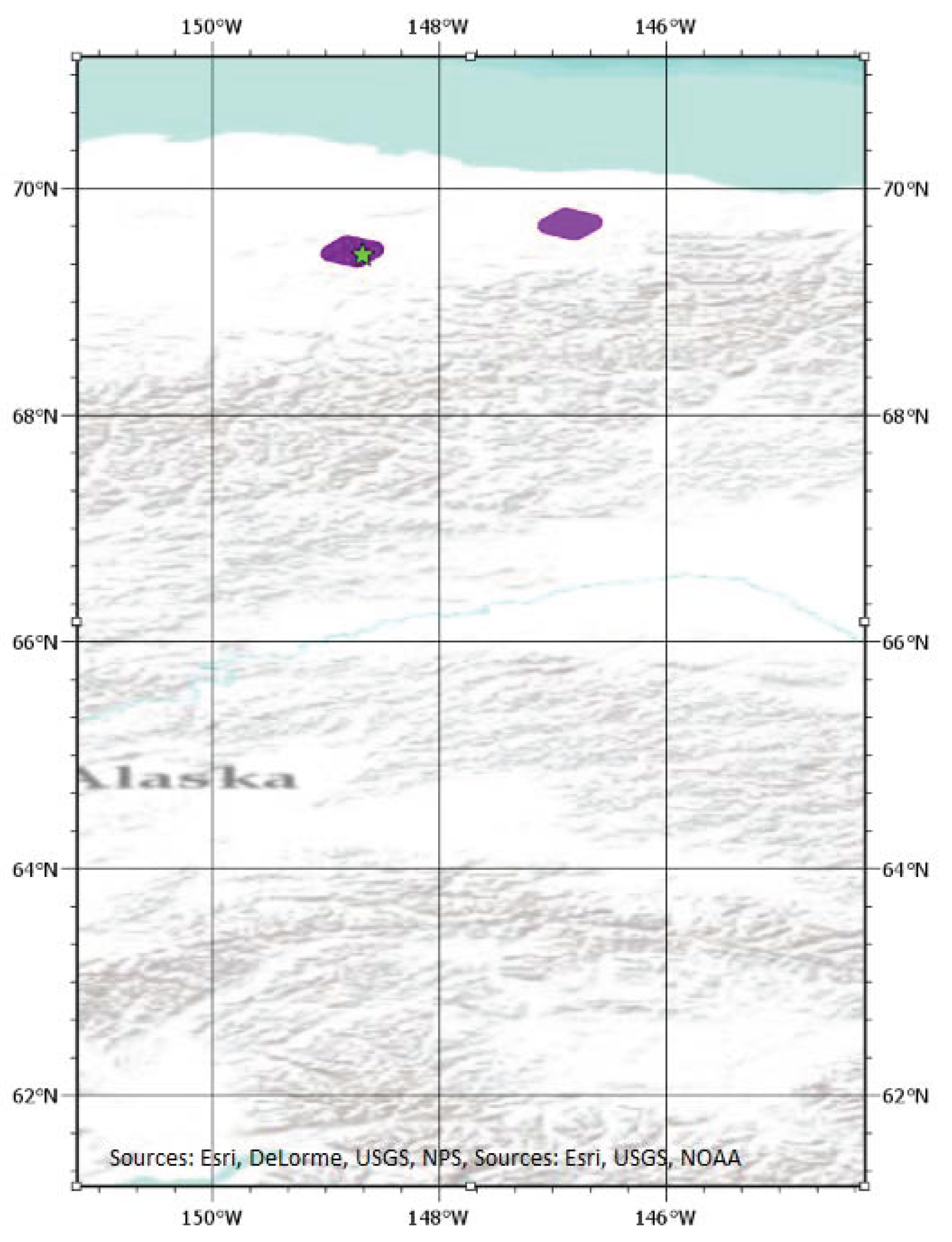
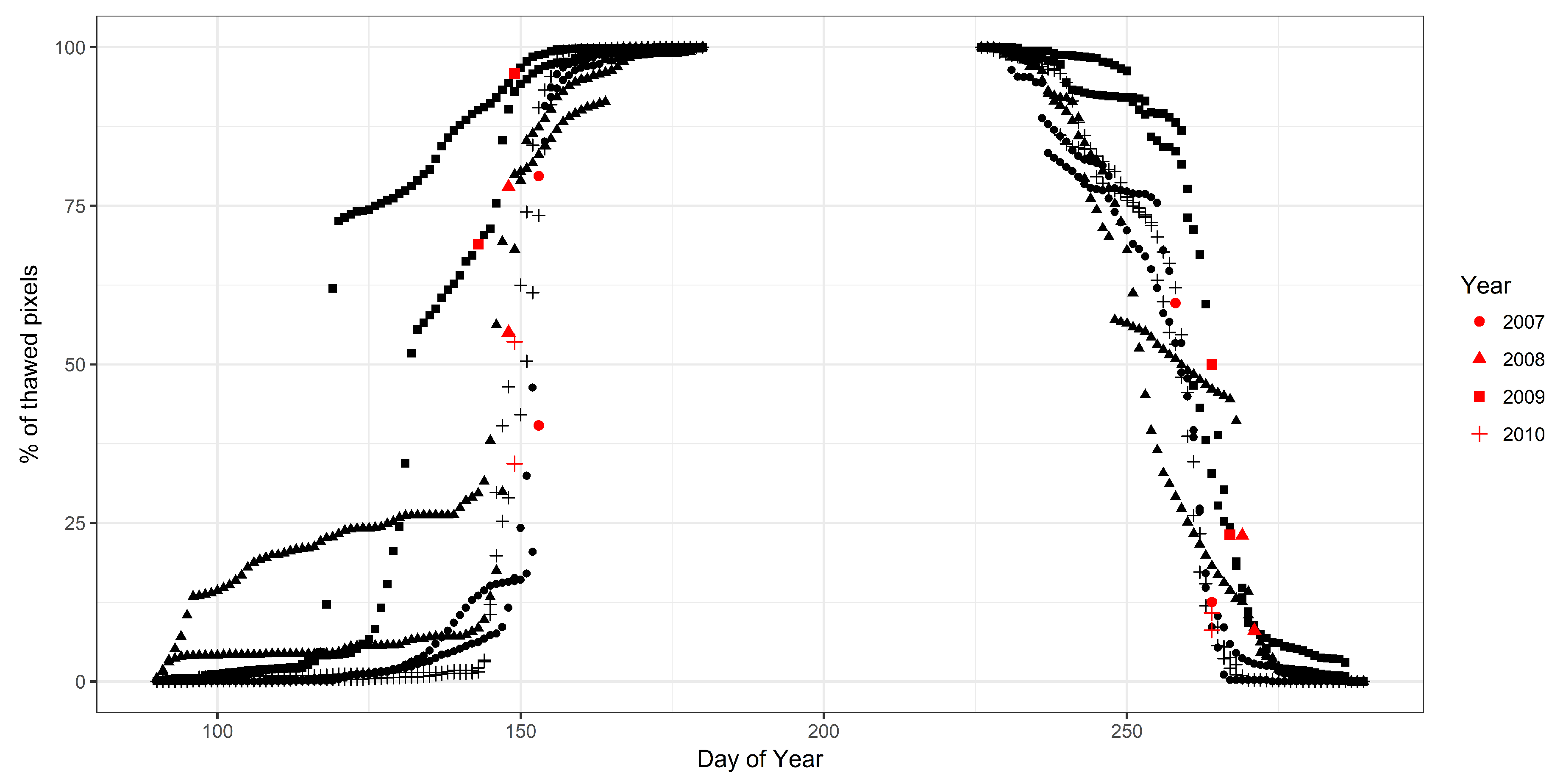
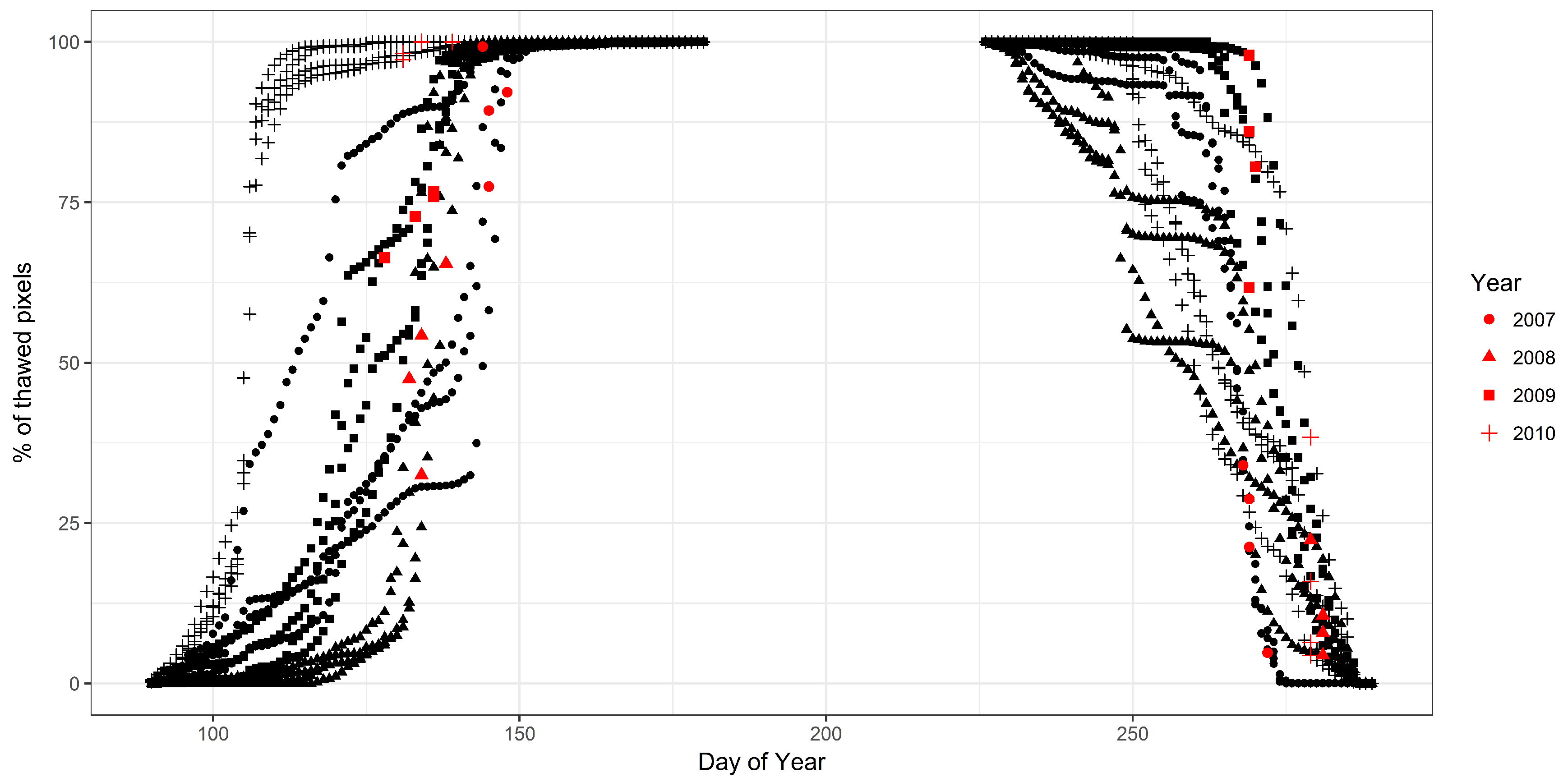
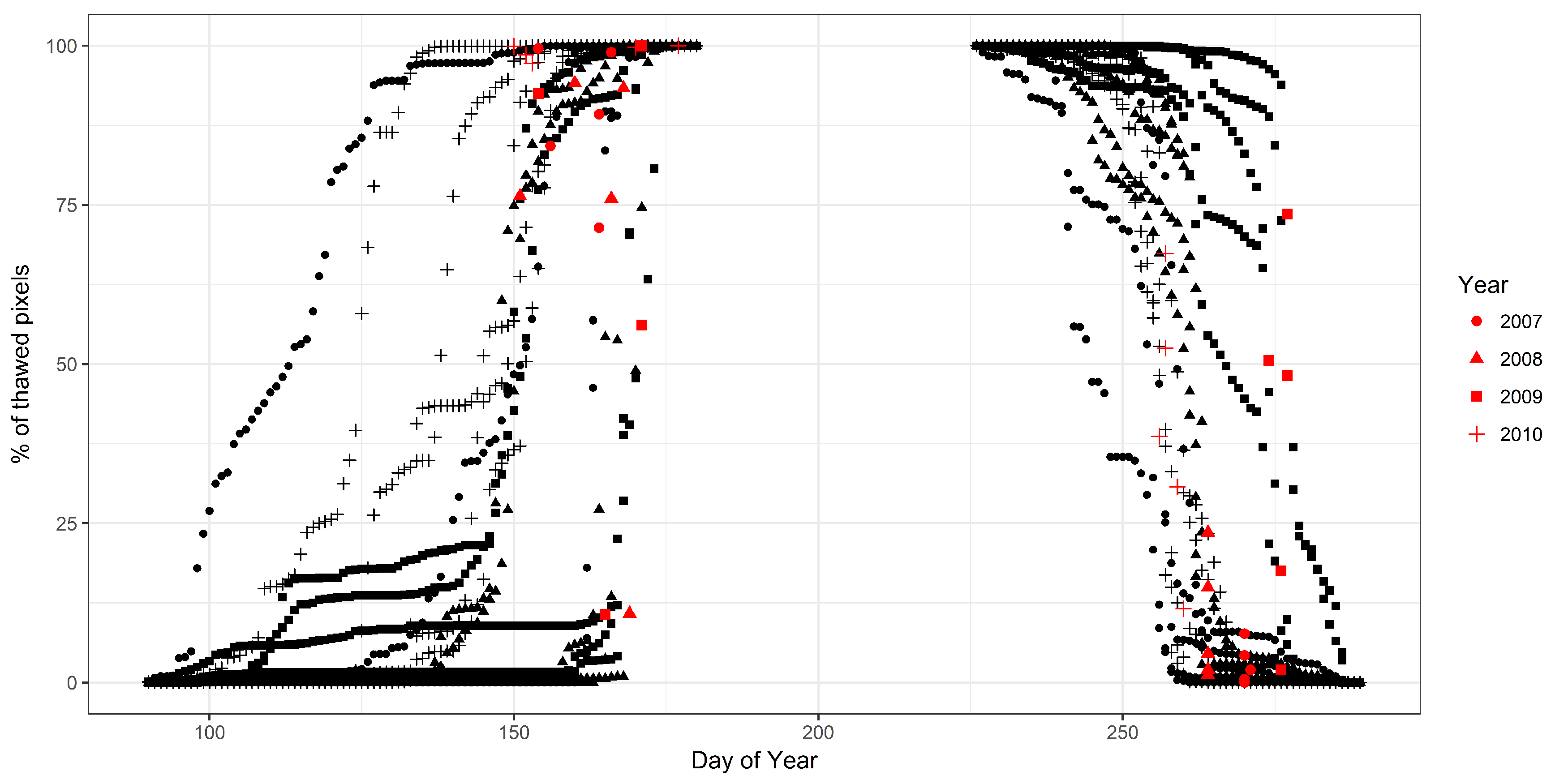
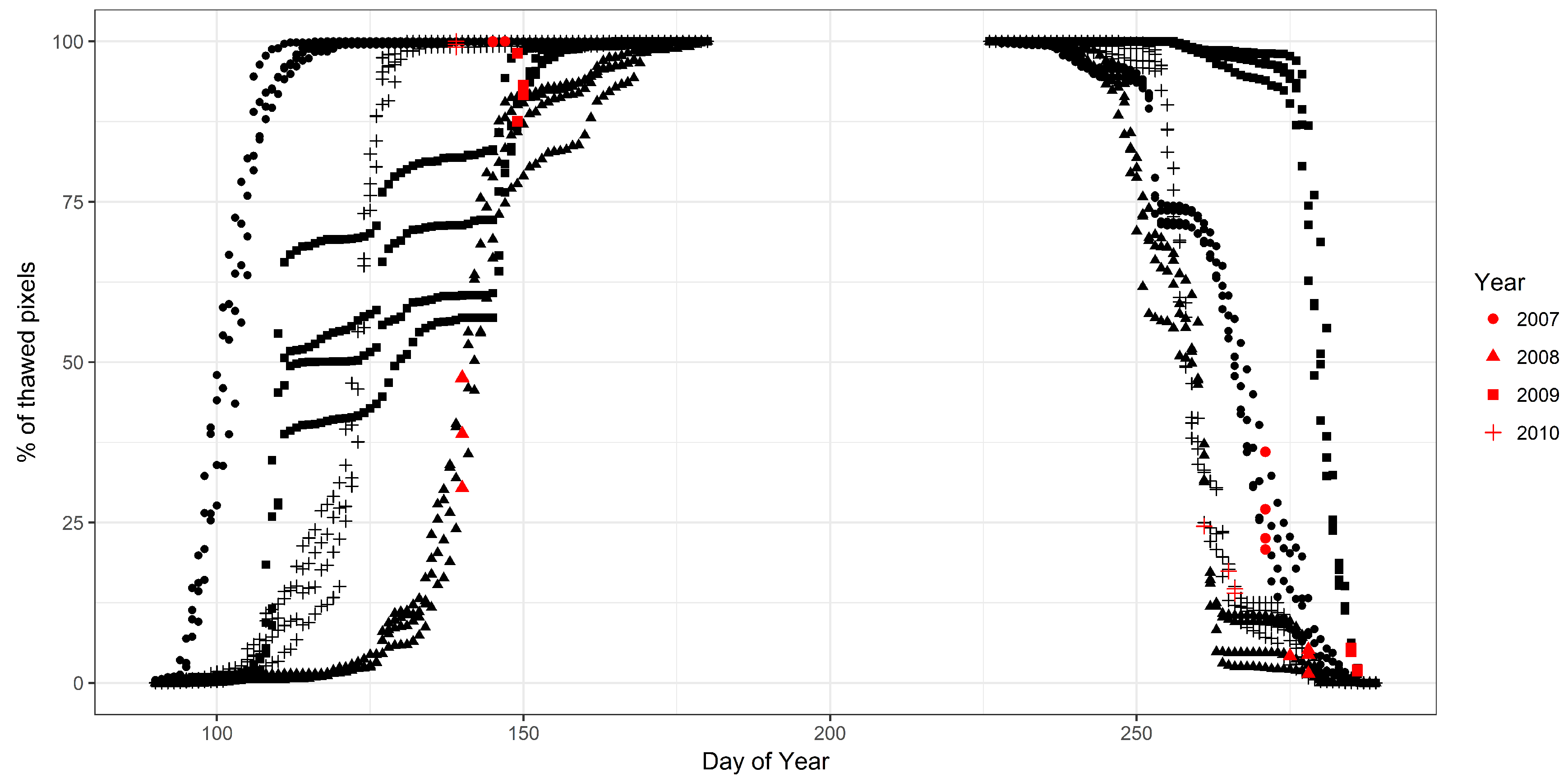
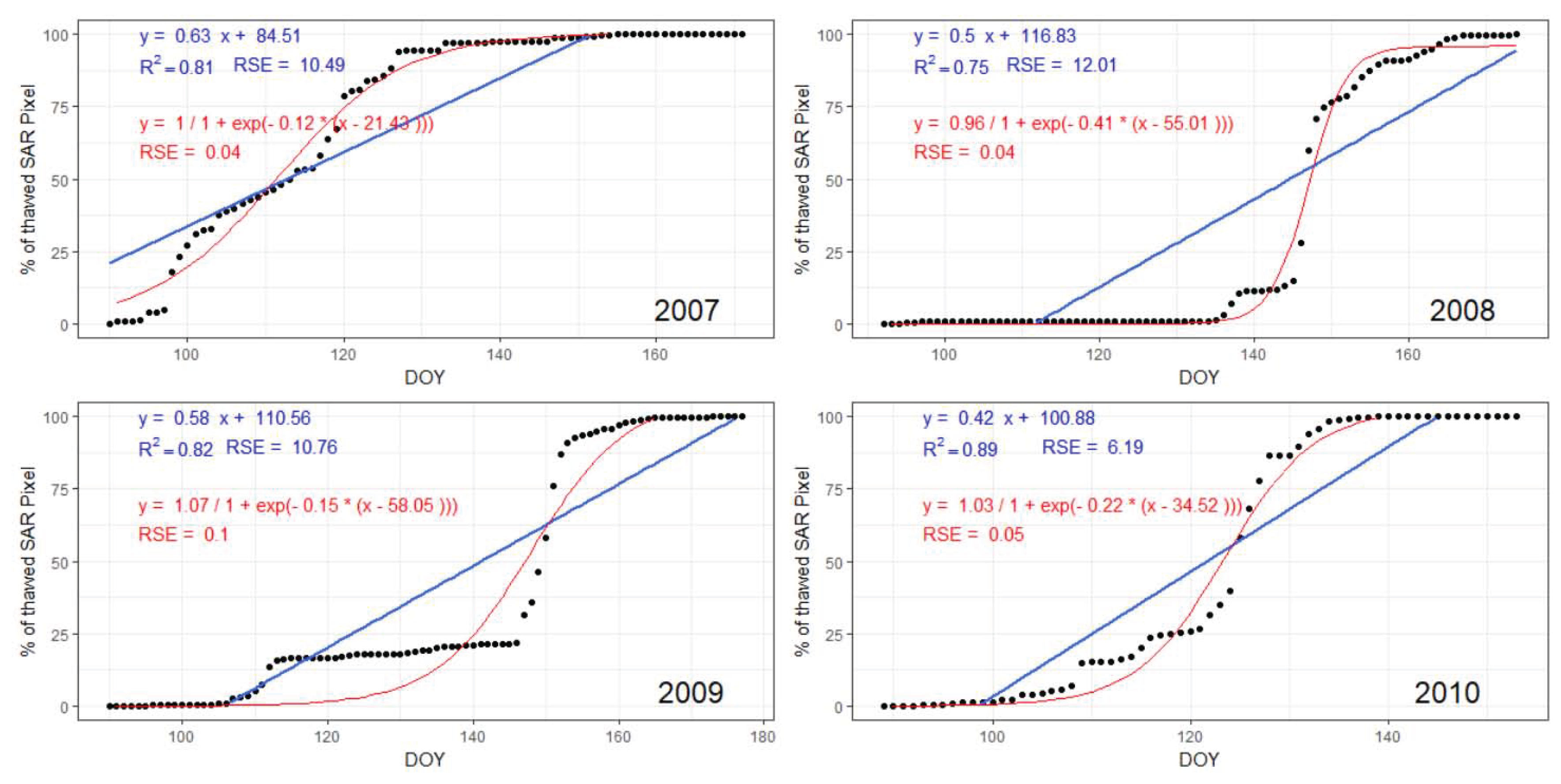
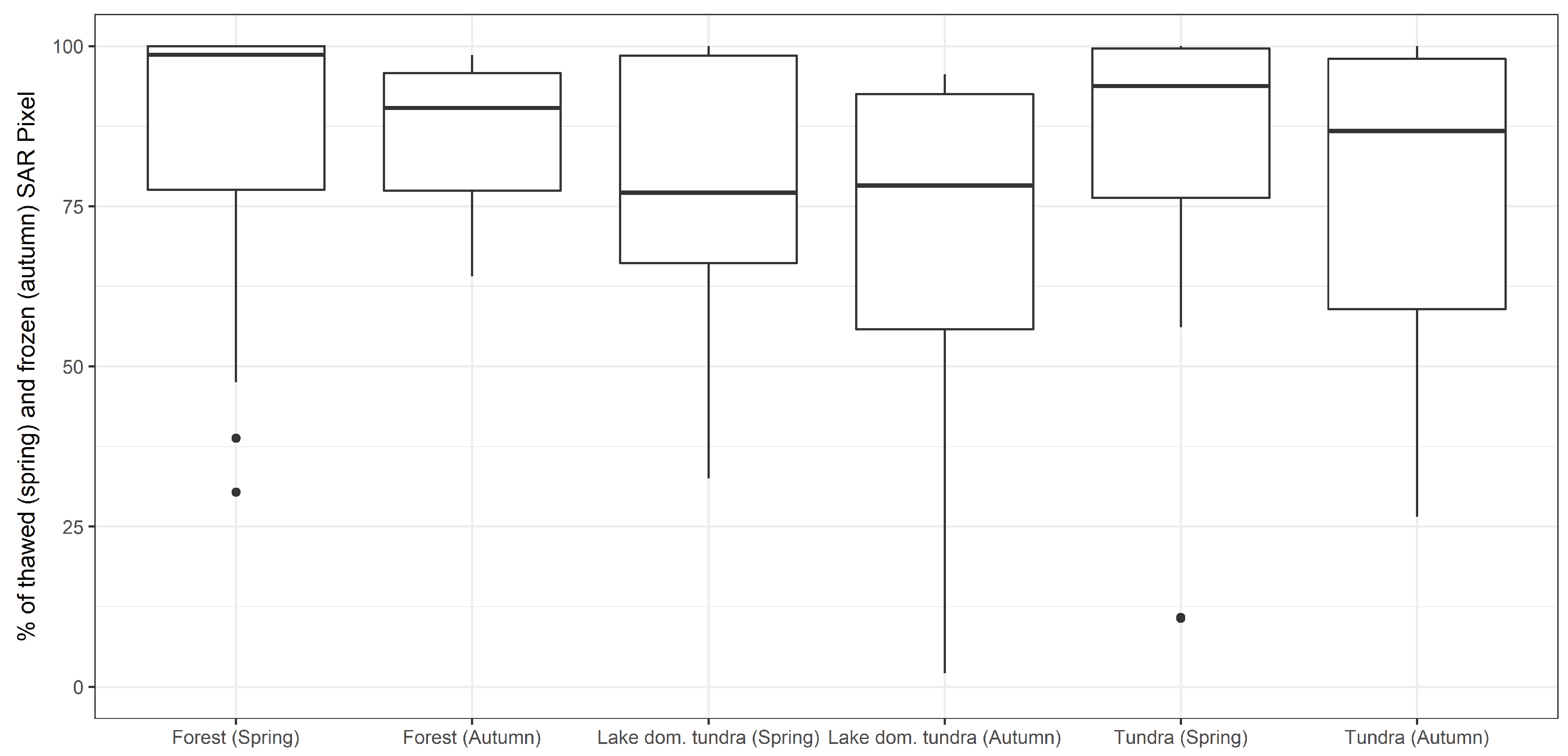
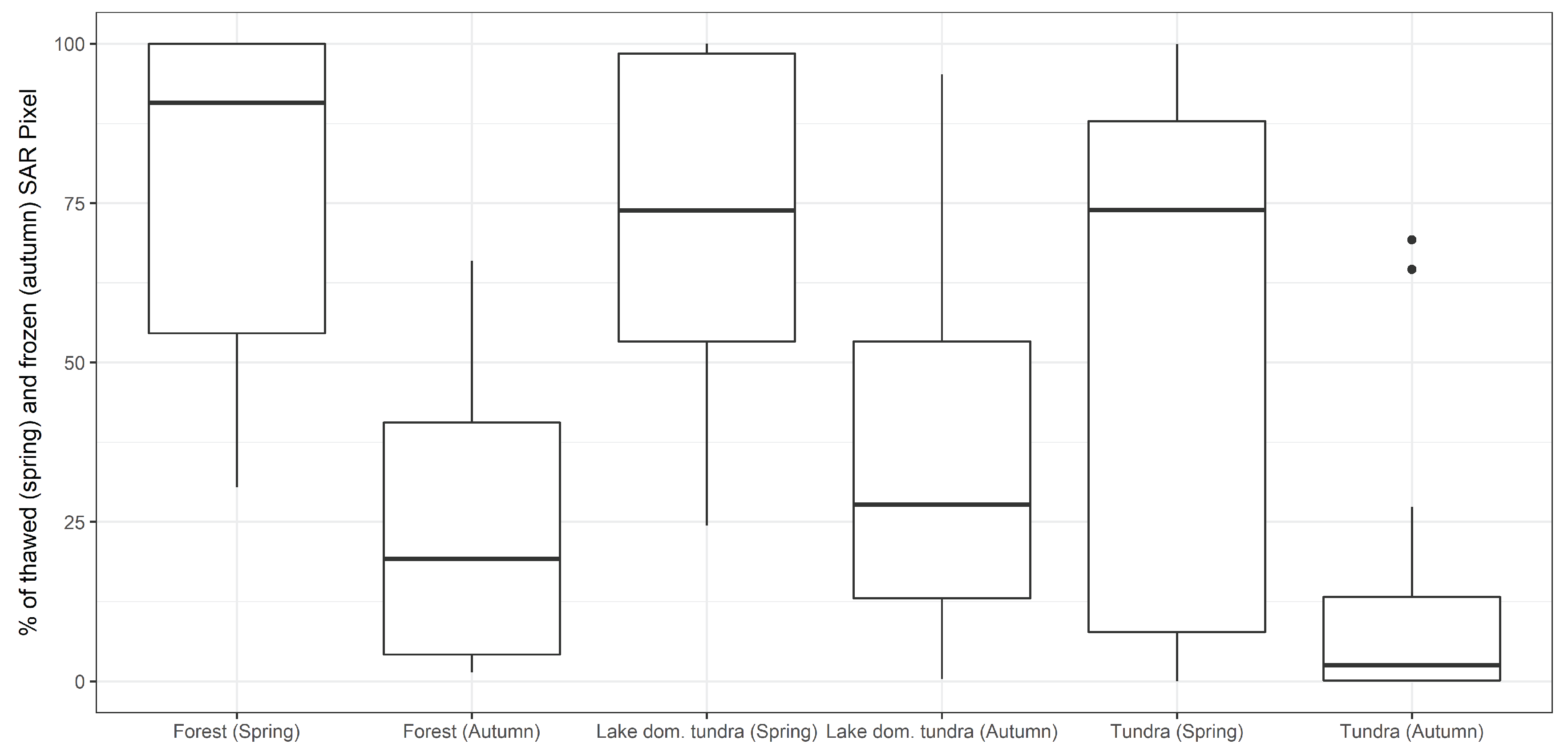
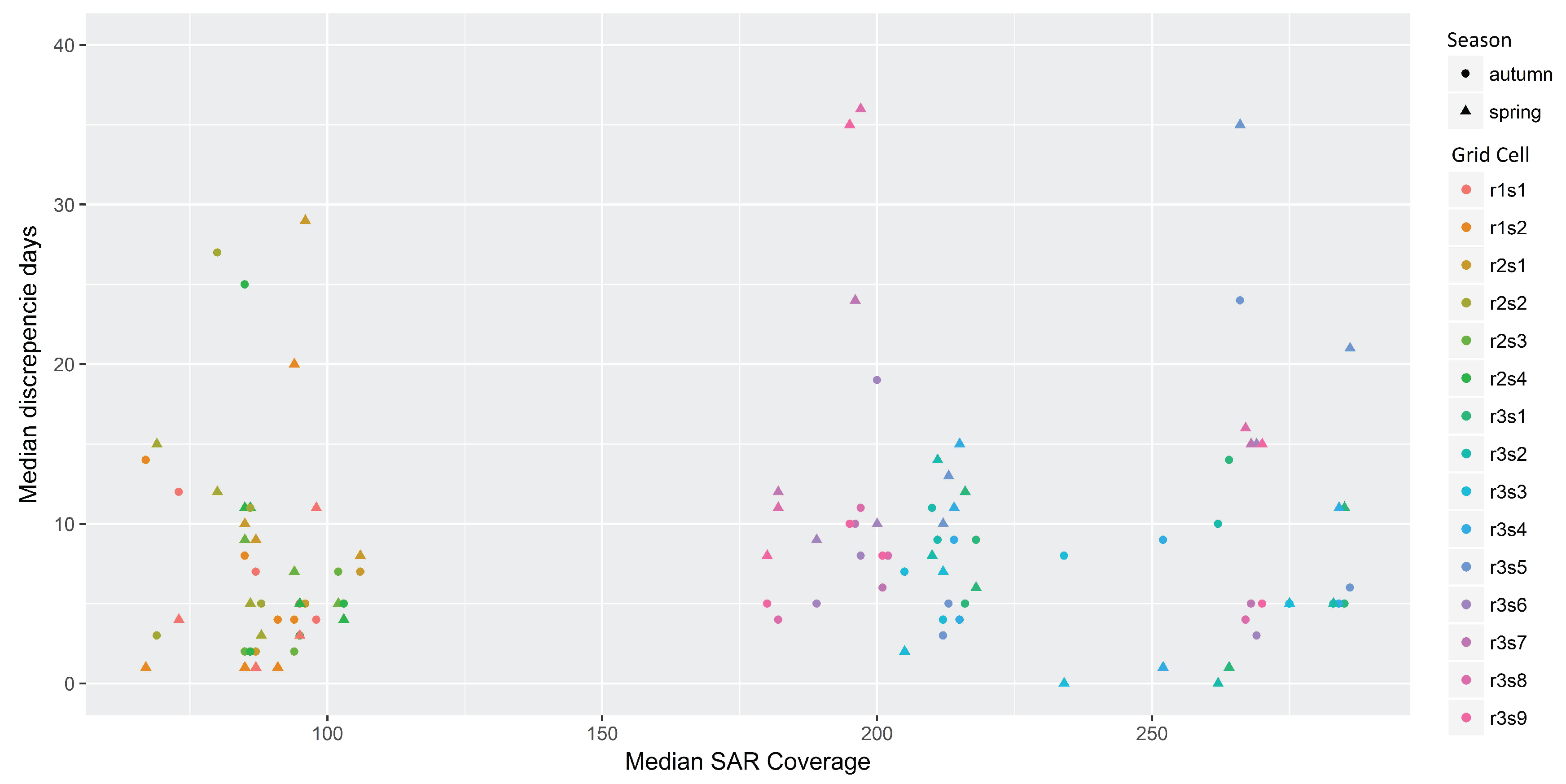
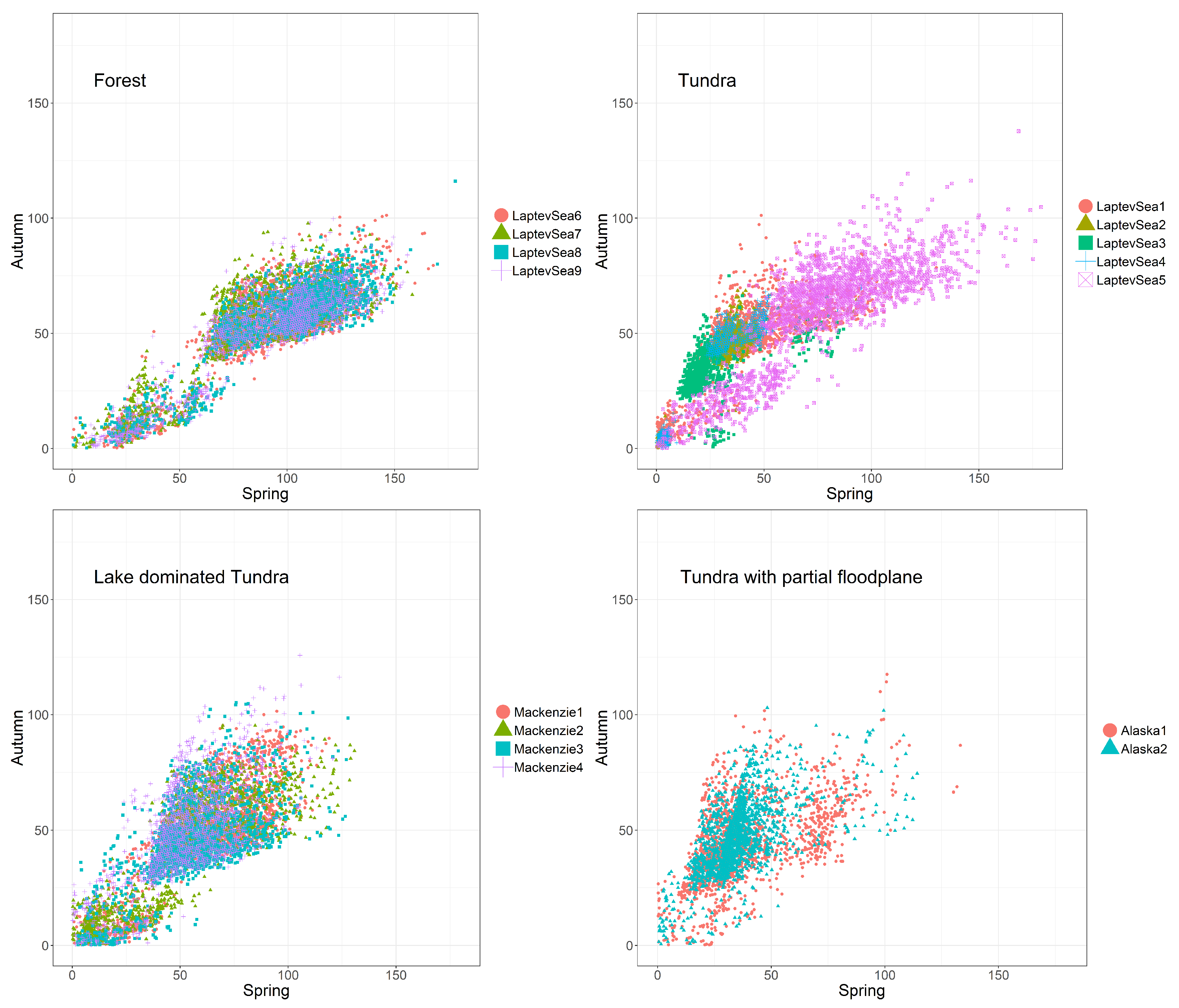
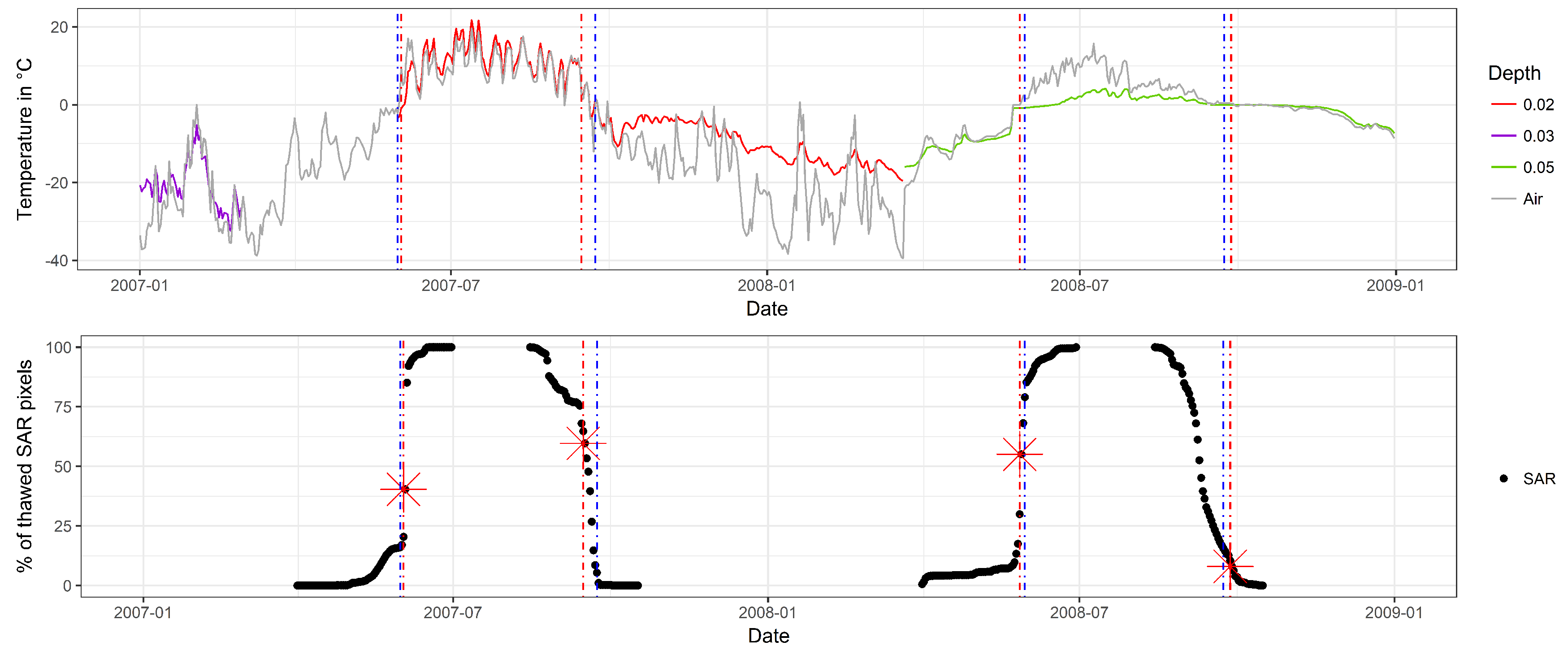
| Site | Latitude | Longitude | Type | EL.Range | SD S. | SD A. | Av.ASAR Acqu.Times | Av.ASCAT Acqu. Times |
|---|---|---|---|---|---|---|---|---|
| Al.1 | 69.698 | −146.842 | FL | 147–328 | 21.25 | 17.17 | 6–8 a.m.; 8–10 p.m. | 04–7:30 a.m.; 7:30–11 p.m. |
| Al. 2 | 69.458 | −148.765 | FL | 149–360 | 14.63 | 14.85 | 6–8 a.m.; 8–10 p.m. | 04–7:30 a.m.; 7:30–11 p.m. |
| Mack.1 | 67.534 | −128.027 | L | 155–283 | 23.84 | 21.64 | 4–6 a.m.; 5–8 p.m. | 3–6 a.m.; 6–9 p.m. |
| Mack. 2 | 68.342 | −126.270 | L | 150–286 | 27.35 | 22.90 | 4–6 a.m.; 5–8 p.m. | 3–6 a.m.; 6–9 p.m. |
| Mack. 3 | 67.927 | −127.694 | L | 150–299 | 21.82 | 18.72 | 4–6 a.m.; 5–8 p.m. | 3–6 a.m.; 6–9 p.m. |
| Mack. 4 | 67.766 | −127.747 | L | 235–380 | 19.27 | 19.70 | 4–6 a.m.; 5–8 p.m. | 3–6 a.m.; 6–9 p.m. |
| Lap.Sea1 | 70.737 | 111.738 | T | 98–330 | 21.36 | 16.24 | 2–4 a.m.; 11 a.m.–3 p.m. | 2–5 a.m.; 9 a.m.–1 p.m. |
| Lap.Sea 2 | 70.607 | 110.869 | T | 375–508 | 7.64 | 7.58 | 2–4 a.m.; 11 a.m.–3 p.m. | 2–5 a.m.; 9 a.m.–1 p.m. |
| Lap.Sea 3 | 70.967 | 104.118 | T | 331–487 | 12.34 | 8.76 | 2–4 a.m.; 11 a.m.–3 p.m. | 2–5 a.m.; 9 a.m.–1 p.m. |
| Lap.Sea 4 | 70.657 | 109.495 | T | 429–606 | 15.62 | 17.93 | 2–4 a.m.; 11 a.m.–3 p.m. | 2–5 a.m.; 9 a.m.–1 p.m. |
| Lap.Sea 5 | 70.623 | 113.418 | T | 16–163 | 31.31 | 22.66 | 2–4 a.m.; 11 a.m.–3 p.m. | 2–5 a.m.; 9 a.m.–1 p.m. |
| Lap.Sea 6 | 69.023 | 104.712 | F | 180–328 | 27.65 | 17.19 | 2–4 a.m.; 11 a.m.–3 p.m. | 2–5 a.m.; 9 a.m.–1 p.m. |
| Lap.Sea 7 | 68.964 | 105.309 | F | 189–304 | 30.85 | 20.16 | 2–4 a.m.; 11 a.m.–3 p.m. | 2–5 a.m.; 9 a.m.–1 p.m. |
| Lap.Sea 8 | 68.853 | 105.228 | F | 179–272 | 27.77 | 17.52 | 2–4 a.m.; 11 a.m.–3 p.m. | 2–5 a.m.; 9 a.m.–1 p.m. |
| Lap.Sea 9 | 68.823 | 105.524 | F | 231-301 | 29.57 | 18.54 | 2–4 a.m.; 11 a.m.–3 p.m. | 2–5 a.m.; 9 a.m.–1 p.m. |
© 2017 by the authors. Licensee MDPI, Basel, Switzerland. This article is an open access article distributed under the terms and conditions of the Creative Commons Attribution (CC BY) license (http://creativecommons.org/licenses/by/4.0/).
Share and Cite
Bergstedt, H.; Bartsch, A. Surface State across Scales; Temporal and Spatial Patterns in Land Surface Freeze/Thaw Dynamics. Geosciences 2017, 7, 65. https://doi.org/10.3390/geosciences7030065
Bergstedt H, Bartsch A. Surface State across Scales; Temporal and Spatial Patterns in Land Surface Freeze/Thaw Dynamics. Geosciences. 2017; 7(3):65. https://doi.org/10.3390/geosciences7030065
Chicago/Turabian StyleBergstedt, Helena, and Annett Bartsch. 2017. "Surface State across Scales; Temporal and Spatial Patterns in Land Surface Freeze/Thaw Dynamics" Geosciences 7, no. 3: 65. https://doi.org/10.3390/geosciences7030065
APA StyleBergstedt, H., & Bartsch, A. (2017). Surface State across Scales; Temporal and Spatial Patterns in Land Surface Freeze/Thaw Dynamics. Geosciences, 7(3), 65. https://doi.org/10.3390/geosciences7030065






